Snakes on a Plane

Hour of Devastation is just round the corner – Magic’s latest and greatest is out this weekend, and it promises a shake-up across multiple formats, and the potentially most busted of them all is…
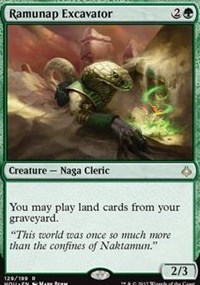
A three mana two/three?
Standard has a bit of a history with three mana two/threes…
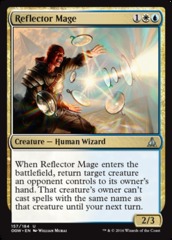
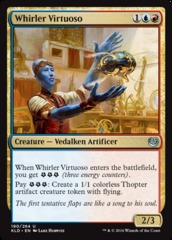
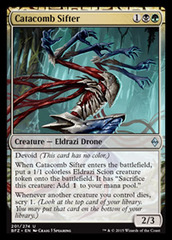
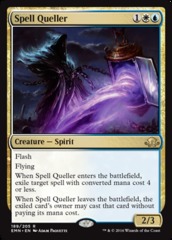
Notice a pattern? They’re certainly not setting the world on fire in combat, but the effects these creatures bring to the table is formidable, and Ramunap Excavator is set to join them.
So, what makes this effect powerful? Any time we get to play a land from the graveyard, we’re getting just shy of a card worth of value per turn, so long as we’re not stranding a number of lands in our hand. One of the ways that springs to mind is with the Amonkhet cycling lands. Cycling a land across the first three turns of the game will allow you to immediately accrue an extra card on turn four, without allowing our opponent to interact before we hit our fourth land drop. In this way, you get a land drop and an extra card for two mana – remind you of anyone?
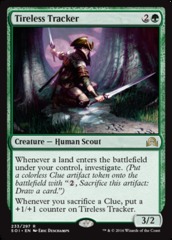
This is a lot more tricky to set up than Tireless Tracker, and the payoff doesn’t leave you with a huge board impact, but is very powerful in tandem with the Human Scout – cycle a land, play it from the graveyard and then draw from the clue – each cycling dual quickly becomes worth three cards, if you can support the mana investment.
The next most obvious synergy is fetch lands – we don’t get to enjoy the plethora available in older formats, but standard’s Evolving Wilds creates an extremely powerful engine. Starting from turn four, Wilds gives us a land drop every turn of the game, so long as the Excavator survives and you don’t run out of basics. While Evolving Wilds gives us the option to play 3+ colours, these decks thrive on mana bases with few basic lands, whereas a two-colour deck is as likely to get an extra card out of the Cultivator on turn fourteen as it is on turn four. Not to mention that we get to run away with value in tandem with Tracker – play a Wilds from the graveyard, draw a card, grow the tracker – it’s like casting a Map the Wastes every turn for two mana, without spending a card. Green-Black Delirium is a natural home for all these cards, and combined with Vessel of Nascency we’re going to be getting an extra card very reliably on turn four:
| Green-Black Delirium (60 cards) | |
| Creatures (18): | Spells (16): |
| 4 Grim Flayer | 4 Traverse the Ulvenwald |
| 1 Walking Ballista | 3 Vessel of Nascency |
| 4 Tireless Tracker | 4 Fatal Push |
| 2 Ramunap Cultivator | 2 Grasp of Darkness |
| 2 Mindwrack Demon | 2 Never // Return |
| 3 Ishkanah, Grafwidow | 1 Dissenter’s Deliverance |
| 1 Verdurous Gearhulk | |
| 1 Noxious Gearhulk | Lands (24): |
| 4 Blooming Marsh | |
| Planeswalkers (2): | 4 Evolving Wilds |
| 2 Liliana, the Last Hope | 4 Hissing Quagmire |
| 6 Forest | |
| 6 Swamp |
Between the Vessels, Wilds and Clue tokens, Fatal Push will reliably be able to take out 4-cost creatures, so we can trim on Grasp of Darkness, which is the driving force making early mana awkward for the deck. The singleton Walking Ballista helps us across multiple angles, shooting down Toolcraft Exemplars, adding two types to our delirium early and is powerful to recur late game with Liliana, where it acts as a powerful mana sink for the extra land drops from Ramunap Excavator.
This deck is leaning in to the Excavator-Tracker synergy – the extra lands you generate with the pair will generate velocity in the mid- to late-game, helping to overwhelm the opponent with sheer card volume rather than a devastating endgame. Using Liliana to buy back Ishkanahs or Noxious Gearhulks is powerful for buying time to get to this stage, and tutoring a Verdurous Gearhulk with a Traverse the Ulvenwald to dump the counters on a Mindwrack Demon can easily swing the game around and present lethal the very next turn.
If we wanted to take even more advantage of our smoother mana we could look to shave on the aggressive elements in Demon and Verdurous Gearhulk and load up with a couple more removal spells (a To the Slaughter would be a welcome addition, with the set of Fatal Pushes clearing up the rabble), working towards a single copy of Ulamog, the Ceaseless Hunger, which we can find with Traverse once we start getting close to ten mana.

Dissenter’s Deliverance is crucial for slower Green-Black decks in the new format, as it gives us an extra removal spell for Heart of Kiran while also helping to buy time against the potential new bad- guy, Metalwork Colossus. Trying to keep a Colossus off the table forever is generally going to be fruitless, and using a Deliverance to remove one for a turn will generally achieve very little as Sanctum of Ugin is likely to spit out two or three of the 10/10s, but being able to take out a key element of their “mana” development, e.g. Hedron Archive or Skysovereign, Consul Flagship can help to strand their monsters in their hand. We have to be the aggressor in the matchup, as we’ll not win if the game carries on, so buying an extra turn is critical. Worst comes to worst, cycling for one mana in a matchup where otherwise it would be dead adds Instant to your Delirium at a low tempo cost. Dependant on the format context, I wouldn’t be surprised if you wanted two or more of these to start.
But what about older formats – can the Excavator bear fruit up against Magic’s all-stars? Whilst fetchlands see a great step change in value, taking turn four off even in Modern to glean an extra card can often leave you dead on the spot. However, Crucible of Worlds is no stranger to the Modern scene, and strapping it on to a creature, while easier to remove, provides a clock while you keep opponents off-balance with Ghost Quarters.
“Hatebear” strategies have danced around the fringes of Modern for years now, and occasionally put up results in the hands of seasoned pilots like Craig Wescoe, but last week a mono-white version took Roanoke by storm in the hands of Brian Coval, utilising powerful mana denial elements in Thalia, Guardian of Thraben, Leonin Arbiter, Tectonic Edge and Ghost Quarter. The deck is powered by a set of Aether Vials, which help develop board presence while expending resources to attack the opponent’s lands.

Ramunap Excavator could bring a resurgence to the Green-White variant of this deck, as the power of the snake in tandem with Ghost Quarter and Leonin Arbiter allows you to Strip Mine your opponent every turn of the game. When you get this kind of engine set up the value of a 2/3 body shouldn’t be underestimated – your opponent’s frequently going to be unable to deal with it under duress, and it provides a real clock. In addition, in a stalled out game you can start to recur Horizon Canopies; investing your land drop and one mana per turn to draw two cards pays off when Aether Vial cheats your creatures out for free.
Looking even further back, the Excavator’s power increases with the lands around it. In Legacy you can set up similar locks to Modern with fewer moving pieces thanks to Wasteland, or otherwise set up abusive locks with Glacial Chasm. The land’s the limit with Ramunap Excavator, and I think we’ve only just scratched the surface of this snake’s potential.
If you have any questions or have perhaps spotted some synergy I have overlooked please let me know in the comments.





